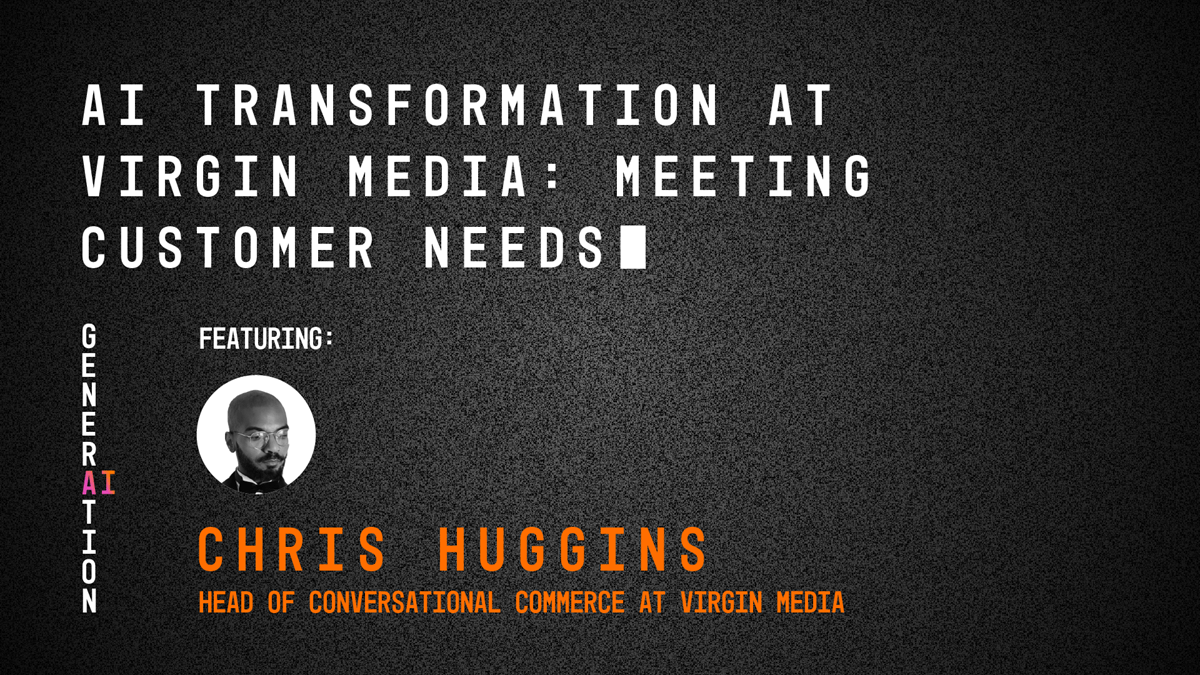PODCAST OVERVIEW
AI transformation at Virgin Media: Meeting customer needs with AI tools
October 26, 2023 • 4 minutes

Personalization and efficiency are often pitted against one another. But with the massive efficiency benefits offered by an AI transformation, businesses can capitalize on non-traditional personalization initiatives without sacrificing time or productivity.
Chris Huggins, Head of Conversational Commerce at Virgin Media, joins our Generation AI podcast to discuss how he and his teams are leveraging behavior signals to enhance customer experience with artificial intelligence tools that increase human productivity and ensure customers get what they need.
Leveraging behavioral signals for enhanced UX
Three key components to focus on and build an AI transformation project around are personalization, agent augmentation, and generative AI. Many see personalization as being contrary to efficiency, but at Virgin Media, Huggins says it’s quite the opposite.
“We’re using online behavioral signals to dictate the user experience within our bot interactions,” he says.
For example, if a customer is interacting on the website via the installation page, their journey will reflect both the behavior it took to get to that page and the typical behavior displayed on that page through the use of inferred logic.
“We know 96 percent of all customers that navigate via the installation page will be asking questions about installation, so we utilize that knowledge within the bot interactions and ensure we’re accelerating the path to resolution by quickly identifying customer intent,” says Huggins.
Arming AI with the information needed to improve interactions
Once customer intent is identified, the next step of the journey falls in line without unnecessary clarifications because the real-time data informs the progress of the conversation. With this information, interactions move toward a resolution in a way that is optimal for the customer.
In practice, this may look like greeting a customer via the direct debit page with something along the lines of “It looks like you’ve got a query about banking. Would you like to change the direct debit date?” or “Do you have a question about your first payment?” instead of asking “How can I help?”
Digging directly into what data has defined to be the top customer queries allows for better personalization and creates an avenue to circumvent unnecessary points of clarification, which will ultimately reduce TWB, or “Time With Bot,” and get customers the results they want and need faster.
Using AI-driven conversational augmentation to increase efficiency
Agent-facing AI systems further help to enhance the UX by increasing the efficiency of the decision-making agents who are interacting with customers, thus allowing them to reach a resolution more quickly.
“We’re utilizing conversational AI to augment our human agents and really tackle those monotonous tasks, such as terms and conditions,” Huggins says.
Instead of leaving these tasks with a human agent, AI automates them using what is essentially a predefined content library of templated responses. In this way, conversational AI assimilates and interacts like top human performers would, which bridges the gap between agents and allows others to yield similar results.
The use of AI in this capacity in customer-facing roles is often in conflict with the idea that the digital space still requires soft skill elements, such as pitch, pace, and tone — elements of a more human intelligence and skillset. However, that’s not a factor in the digital space the same way it is in the analog space.
In the digital space, conciseness and speed of response are more highly valued, and conversational tonality can be easily replicated by bots.
Prioritizing customer experience and operational excellence
“The goal of implementing these AI systems is to contain by design. When I talk about containment by design, what I’m talking about is either the conversation resulting in a conversion, or we’ve delivered the necessary information the customer was seeking,” says Huggins.
The end goal is to create one optimal experience in call centers and beyond. It’s about customer-centricity and bringing the best possible experience to the customer, even with the more complex issues. The more everyone works toward this goal, the more efficiency and ease of use become a staple of the brand.
The AI transformation goal is always to better understand what works well for customers and what works well for a cost-effective operation. However, it may be that business objectives aren’t necessarily aligned with customer preferences. This is where it becomes important to deliver a consistent experience over all platforms.
Delivering a consistent CX across all platforms
“Customers’ situations change. A customer who starts a conversation online might need to step into the analog space, but the customer who starts a conversation in the analog space might need to then step into messaging. We should be building solutions that are capable of moving between spaces,” says Huggins.
If all objectives are aligned toward delivering a consistently optimal customer experience across all platforms, there is less likelihood of encountering the same friction points that others have experienced trying to grow in this area.

